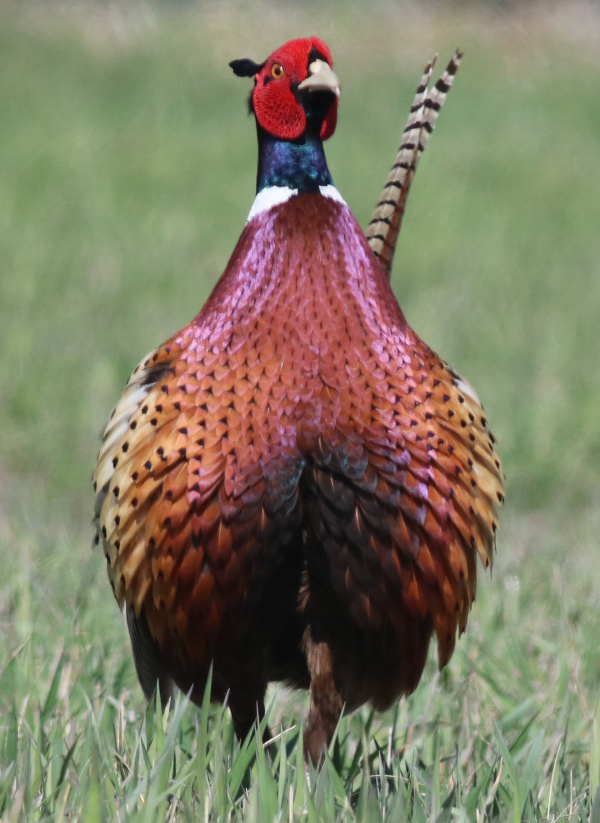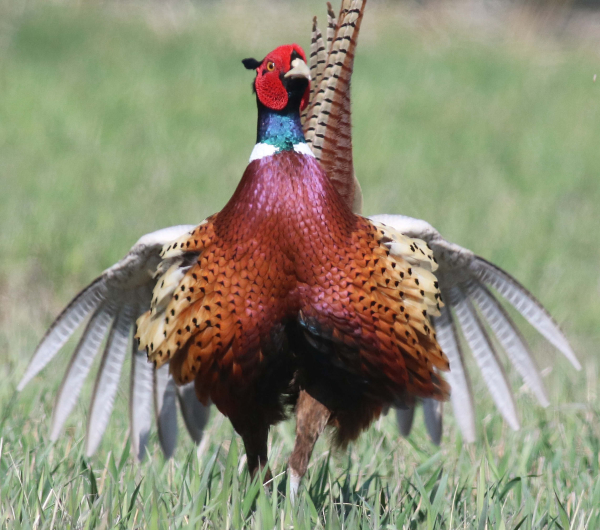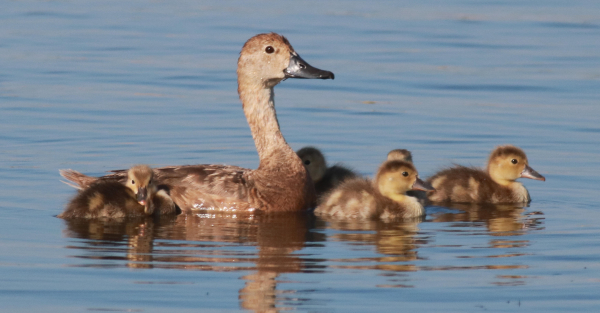
Although we wish we had a few of Ed Bry’s intimate bird photos to illustrate this article, his photos inspired Paul’s interest to try to take comparable images using modern equipment and a similar passion for bird photography.

This dramatic Ring-necked Pheasant photo and the first pheasant image above were part of an 8-photo series that comes closest to Ed Bry’s classic photo of a Ring-necked Pheasant crowing that has been a feature of Paul’s office.

Ed was able to show birds at their best, their most relaxed, and their most vulnerable stages of their lives. Ducks, such as this Redhead hen and brood of days old ducklings, were favorite subjects of his.

Another of Paul’s favorite photos in the Ed Bry collection shows a Short-eared Owl standing on her ground nest, holding her wings out to her sides to shade a brood of growing nestlings. The adult Short-ear stared into Ed’s camera with this owl’s intent look.
|
Some years ago, when I was a young bird biologist a year or two into photographing birds, I had a fun first encounter with one of my favorite photographers – Ed Bry. Over the years, Ed had been an excellent silent mentor, just by providing his photos of birds and other wildlife in the monthly pages of North Dakota Outdoors. As the editor of the publication, by publishing and thereby sharing photos that he took over years of time, I was able to study Ed’s images one after another, and aspire to taking photos of that caliber.
One afternoon while driving slowly along the road that bisects the expansive wetlands south of the little town of McKenzie, east of my hometown of Bismarck, I was searching among the variety of ducks, wading birds, shorebirds, and songbirds for photo subjects with some success. There weren’t many wildlife photographers in Dakota then, so I was surprised when I noticed a station wagon a distance behind me with a telephoto lens poking out the driver’s side window. The vehicle and photographer continued to follow a distance behind me in similar fashion, stopping periodically to photograph, then continuing south. At the end of the miles-long marsh, we both pulled over to visit, and that’s the first time I met my friend Ed Bry.
We talked about photographing birds, McKenzie experiences, and shared our photo equipment with one another. It was great fun to interact with another wildlife photographer, much less someone I appreciated so much, and Ed was nice enough to invite me to stop by his office anytime.
By that time, Ed had switched over to color slide film, which was the norm until the turn of the century for most photographers. But his publication still had plenty of black and white pages, so he continued to be known for his black and white photography. So impressive were Ed’s photos and his extensive photo files, that when the authoritative book, Breeding Birds of North Dakota was published by Bob Stewart in 1976, Ed’s photos were used to illustrate most of the species accounts with vivid intimacy.
Ed used a portable tent-like blind in the field, often setting it up at a location with a variety of birds, then waiting to see what would reveal itself to his camera during photo sessions. He even left his blind in position for several weeks to reuse the site through the season. He also used my preferred “mobile blind” technique, as evidenced during that first interaction south of McKenzie.
Publications Too
Over the years, I made many visits to Ed’s office, and it was always fun to talk about what he was photographing each time, and share my field experiences. Eventually, I contributed my own photos and articles to his publication. By that time I had published a few scientific articles, but I always believed that in addition to sharing field research with other biologists through scientific publications, it was important to share that information with the public too, with a more conversational journalistic style. Therefore, I offered Ed first option to publish my North Dakota public-oriented articles. After all, North Dakota Outdoors was distributed to tens of thousands of people across the state and beyond.
In essence, these public-oriented articles provided a less formal opportunity to write about birds. Ever since, I’ve zig-zagged between two professions, zigging through years of field studies on birds, and zagging through other periods working as an editor of birding magazines, websites, and books (actually as a writer, editor, and photographer). In addition to writing many hundreds of articles about birds and birding, almost all illustrated with my photos, I’ve also edited and published thousands more articles provided by other birders, biologists, writers, and photographers to share with birders over the years.
Certainly, many people have been instrumental in my development as an ornithologist, as a writer and editor, and as a photographer. Luckily, I have had several instrumental mentors who have added to my interests and professional endeavors. Along the way, I have always been aware of the voice I’ve been given, and I always hope I help, inform, and inspire others to enjoy like interests – and perhaps they in turn will pass along an enthusiasm for enjoying birds and benefitting them in many ways.
Through the pages of The Birding Wire, I hope young birders, beginners, advanced, and senior birders all glean some fun and inspiration each week as we progress through the seasons together. Enjoy the birds in your life; whether they are incidental, attracted by your feeders and landscaping, or whether you savor time afield in search of more birds, new birds, and new outdoor birding experiences. Be sure to enjoy this period as we slip from spring to summer – a prime time for birds and birding.
Article and photos by Paul Konrad
Share your birding sightings and photos at editorstbw2@gmail.com